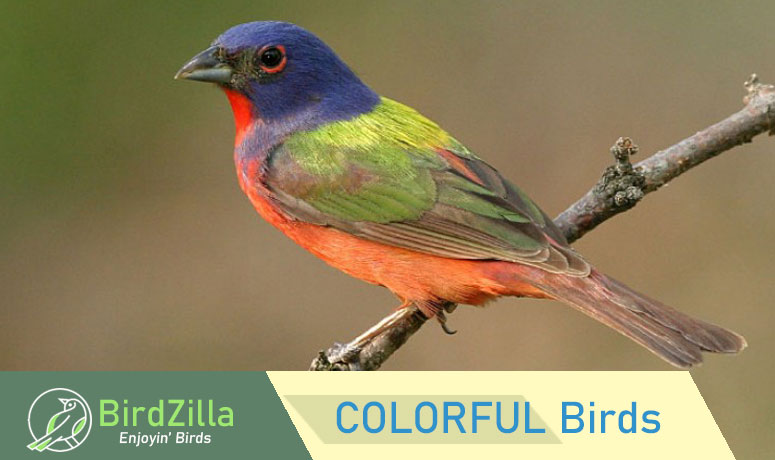
Are you fascinated by the diverse range of colors that can be found in the avian world?
Well, get ready to be wowed, because today we’re going to be exploring a group of birds that take color to the next level.
We’re talking about the most colorful birds (or mixed-color birds) – those feathered creatures that boast a stunning combination of hues that will take your breath away. From blue and orange to red and yellow, mixed-color birds come in a wide array of striking and sometimes unexpected color combinations.
In this article, we’ll dive into the world of these vibrantly colored birds, learning about some of the species that exhibit this unique characteristic and the science behind their incredible colors. So, sit back, relax, and prepare to be amazed by the beauty of the most colorful birds!
On this page
- #25 Cedar Waxwing
- #24 Wood Duck
- #23 Broad-Tailed Hummingbird
- #22 Northern Cardinal
- #21 Summer Tanager
- #20 Blue Grosbeak
- #19 Costa’s Hummingbird
- #18 Baltimore Oriole
- #17 Steller’s Jay
- #16 Calliope Hummingbird
- #15 Yellow Warbler
- #14 Hooded Oriole
- #13 Scarlet Tanager
- #12 Blue Jay
- #11 Scissor-Tailed Flycatcher
- #10 Rivoli’s Hummingbird
- #9 Green Jay
- #8 Lazuli Bunting
- #7 Ruby-throated Hummingbird
- #6 Western Tanager
- #5 Allen’s Hummingbird
- #4 Black-Chinned Hummingbird
- #3 American Goldfinch
- #2 Northern Flicker
- #1 Painted Bunting
#25 Cedar Waxwing
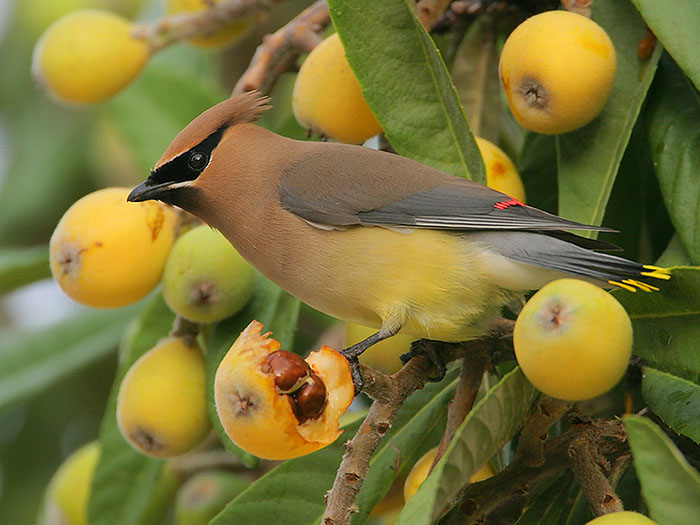
Cedar Waxwings are warm brown birds with a sleek crest and a narrow black mask bordered with white. Both sexes look alike and have a black throat, short black beak, and pale yellow belly.
They also have a gray rump and a dark tail with a yellow tip. This species has a few tiny red dots and a white line on its wings near its back.
We often see Cedar Waxwings in bounding flight and using their long, grayish wings to sally into the air for bugs. This colorful bird lives in parks, a variety of woodlands, and many urban areas.
#24 Wood Duck
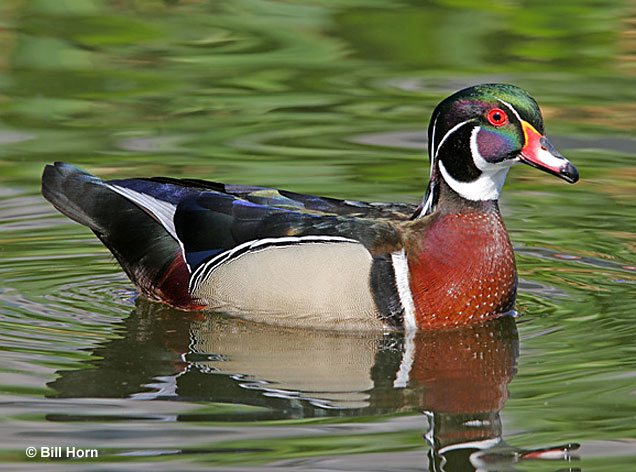
The Wood Duck is a fancy waterfowl species with a longish tail, rounded head, and a short beak. Male Wood Ducks are dark green above and have a dark green drooping crest, black and white face, and a bright red beak. They also have a chestnut neck, chest, and undertail, and yellowish sides.
Female Wood Ducks are gray-brown birds with small white markings on their underparts, a white belly, and a big white eyering. In flight, both sexes show long dark wings with a bit of white on the trailing edge.
We can find Wood Ducks in wooded swamps, on lakes, and in some parks.
#23 Broad-Tailed Hummingbird
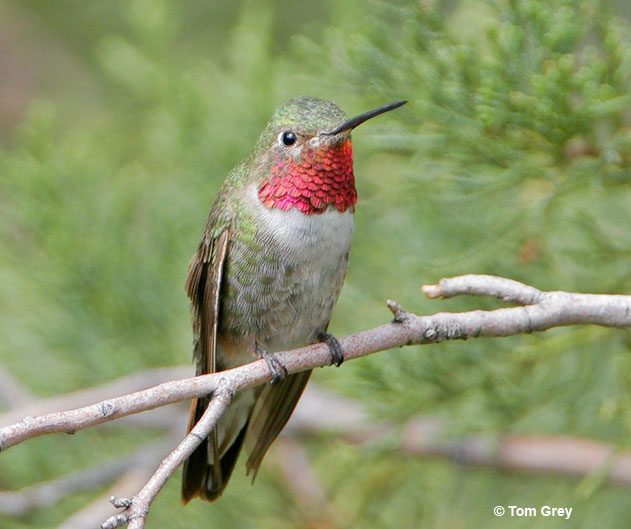
The Broad-tailed Hummingbird is a small bird with green upperparts, pale eyering, and a needle-like beak. Males have a rose-red throat that glows in certain lighting. They also have pale underparts with green and buff on their flanks and belly and a dark tail.
Female Broad-tailed Hummingbirds have small spots on their throat and have buffy underparts. They also have a broad, green tail with a red-orange base, and a black and white tip.
This species is a summer resident of alpine meadows and other high-elevation habitats in the Rocky Mountains. Every so often, one also shows up at a feeder in eastern North America.
#22 Northern Cardinal
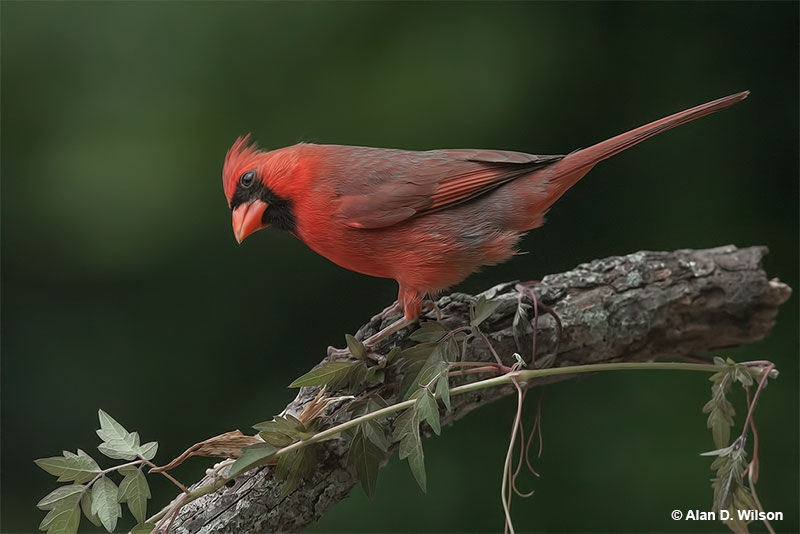
Northern Cardinals might win the prize for being the most beautiful common bird in North America. Male cardinals are red with jet-black highlights on their throat and face. With a closer look, we can see dusky red on their back, tail, and wings, and eye-catching scarlet on their head and underparts.
Females aren’t as brightly colored. However, with their soft tan colors and red highlights, they are still beautiful birds in their own, subtle way. These medium-sized birds also gain fans with their perky crest and big red-orange beak.
We find Northern Cardinals in parks, gardens with lots of native vegetation, and second growth.
#21 Summer Tanager
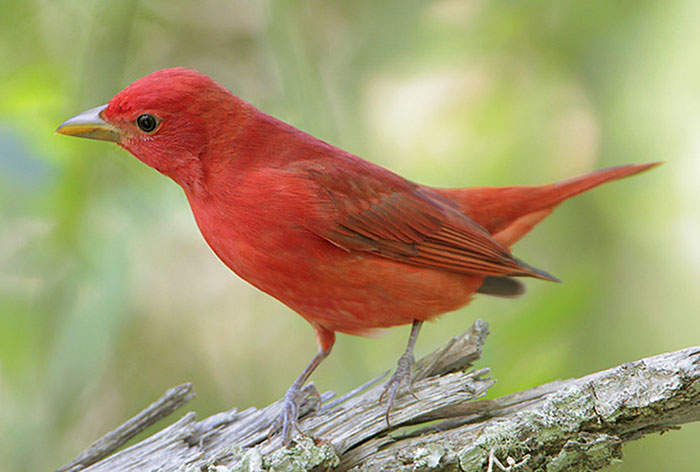
Summer Tanager
The Summer Tanager is a medium-sized bird with a biggish pale or grayish beak and a short, peaked crest. They don’t have any markings on their wings and have rather short, plain tails.
Male Summer Tanagers are lovely, rose-red birds with some dark edging in their long wings. During their first spring, males are yellow-green with red patches.
Female Summer Tanagers are olive or olive-yellow and have some dark edging in their wings. They also have a pale, broken eyering and can show some small bits of red.
This beautiful bird is a summer resident in oak woodlands, parks, and other wooded habitats.
#20 Blue Grosbeak
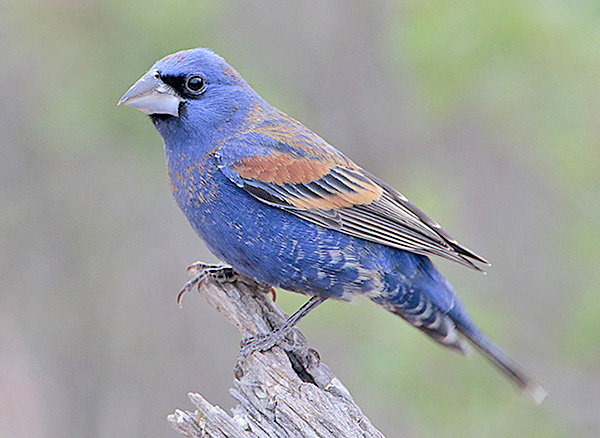
Photograph © Greg Lavaty.
The Blue Grosbeak is a finch-like colorful bird with a strong conical beak and short, peaked crest. Male Blue Grosbeaks are dark blue, have a gray and black bill, and a little bit of black on their face. They also have blackish wings with chestnut wing bars and a dark, rounded tail.
They have some dark streaks on their back and a blue rump. Female Blue Grosbeaks are pale, gray-brown or tan, sparrow-like birds with buff marks in their wings and some dark streaks on their back. They also have a hint of blue on their tail.
We can see Blue Grosbeaks in brushy fields and second growth.
#19 Costa’s Hummingbird
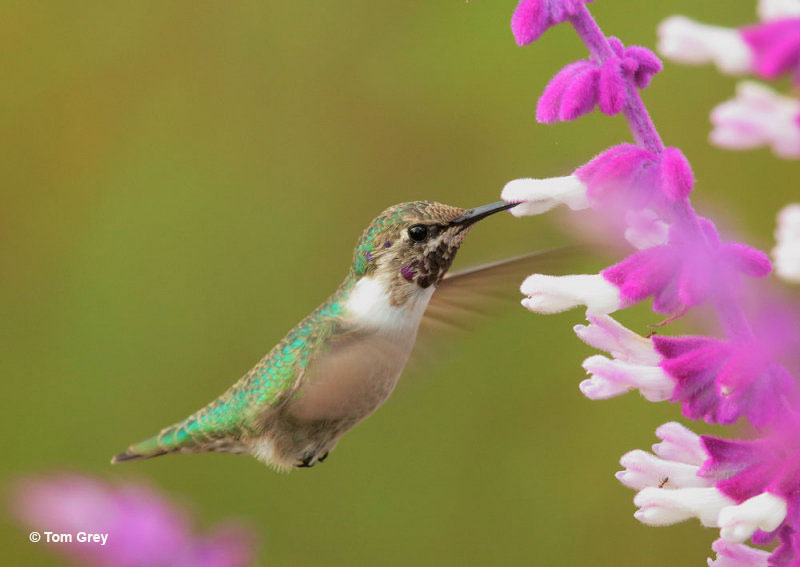
The Costa’s Hummingbird is a tiny desert hummingbird with a somewhat short, slightly curved beak and pale green upperparts. They also have a small white line above their eyes. On females, this white line extends back onto the back side of its face.
Hummingbirds are very colorful but this male Costa’s Hummingbirds have a deep purple crown and throat patch with elongated sides. They have a white chest, white on the side of their neck, and a short, dark tail.
Female Costa’s Hummingbirds have a plain white throat, pale underpart with a hint of green on their flanks, and a pale green tail with a black and white tip.
#18 Baltimore Oriole
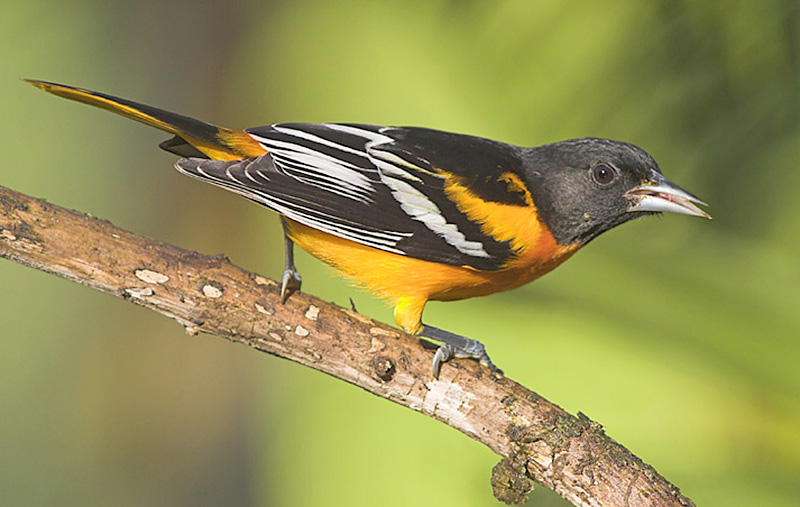
The Baltimore Oriole is a medium-sized blackbird species with a sharp black and gray beak. Adult males are deep orange with a black head and upper back. They have black wings with orange shoulders, a white wing bar, and other white markings.
Male Baltimore Orioles also have orange and black tails. Young males and female Baltimore Orioles are orange or yellow-orange with dark or grayish backs, and have two pale wing bars. They can also have a bit of black near their eyes, and some females have grayish bellies.
We can see Baltimore Orioles in parks and all sorts of woodland habitats.
#17 Steller’s Jay
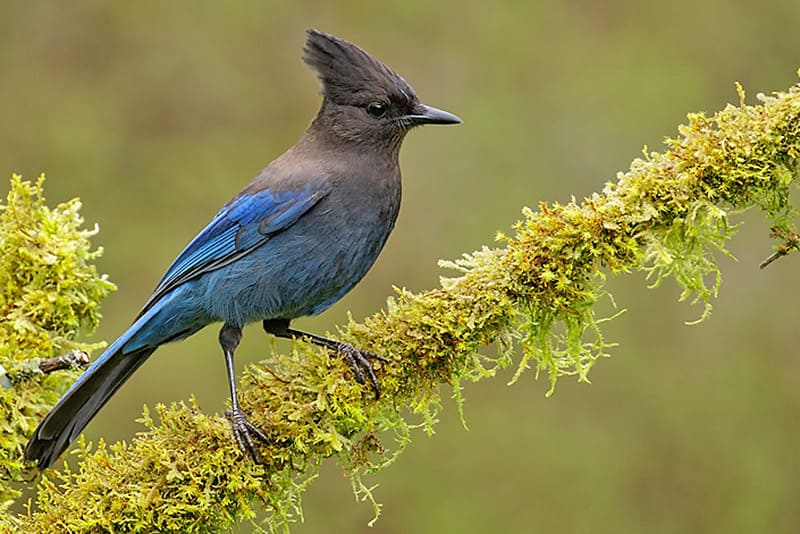
Photograph © Glenn Bartley.
The Steller’s Jay is a hefty, dark blue bird with a tall blackish crest that is fading nicely. Both sexes look alike and have straight black beaks and a sooty gray or blackish head, chest, and upper back. Some birds also have bits of white near their dark eyes.
This jay species has dark blue on its belly, undertail, and rump, and some black barring on bright blue wings. It can also have some black barring on its broad, longish blue tail.
Young Steller’s Jays resemble adults but are paler and have grayer plumage. We find this noisy and pretty bird in coniferous forests and other western woodland habitats.
#16 Calliope Hummingbird
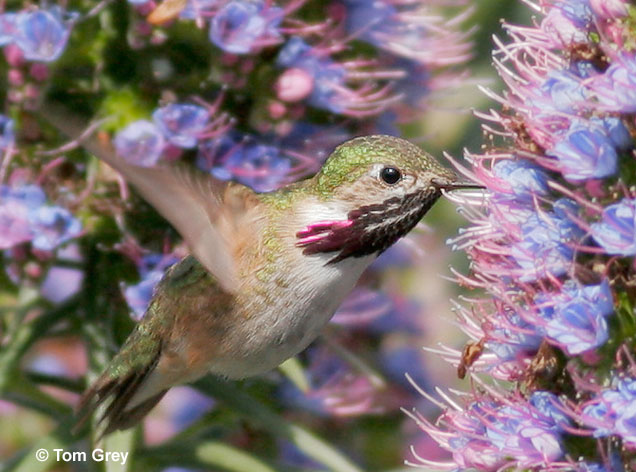
The Calliope Hummingbird is a tiny hummingbird with a straight, needle-like bill and a small pale spot behind each eye. These small birds also have a narrow white line from the top of their beak to below their eyes, and green upperparts.
Related: How do hummingbirds get their colors?
Male Calliope Hummingbirds have iridescent, lavender-rose streaks on their throats, pale underparts with gray-green flanks, and some buff on their undertail. They also have a short, dark, slightly forked tail.
Female and young Calliope Hummingbirds have pale throats with some small dark markings and buff underparts. Their tail has a black and white tip.
This species lives in semi-open and brushy habitats.
#15 Yellow Warbler
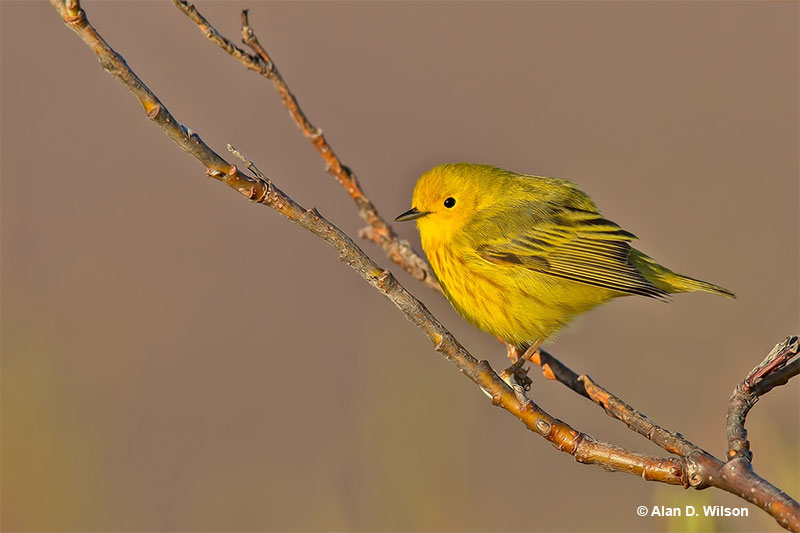
© Alan D. Wilson
Yellow Warblers are small, common and active colorful warblers of parks, wetlands, brushy fields, and all sorts of second-growth habitats. Breeding males are bright yellow birds with some chestnut streaking on their underparts. They also have yellow-olive upperparts and yellow edging in their longish wings.
Females and young fall male Yellow Warblers are olive above and yellow below with some blurry olive streaks. They can also show some pale yellow and white edging in their wings, often have a yellow eyering, and always show yellow spots in their tail.
Occasionally, young birds have grayer plumage, although they always show some yellow, especially in their tail.
#14 Hooded Oriole
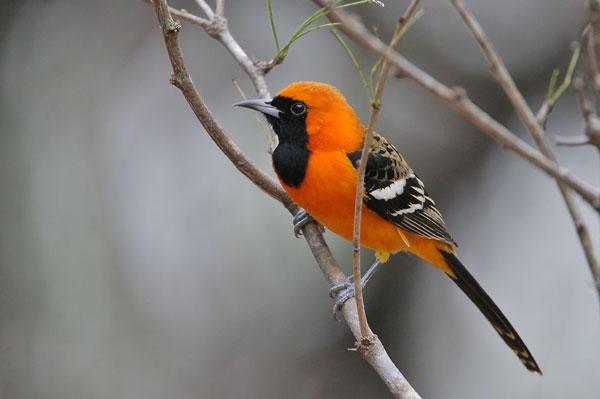
Photographs © Greg Lavaty.
Hooded Orioles are a smallish, slender oriole species with a sharp gray and black beak. They have a long, slightly rounded tail, and their beak often shows a curved tip.
Adult males are deep orange with a black face and throat, a black patch on their back, and black tail. Adult male Hooded Orioles also have black wings with some white markings.
Young males are orange-yellow with a black face and throat, gray back, and gray wings with some white markings. Female Hooded Orioles resemble males but lack black and have dingier yellow and gray plumage.
Hooded Orioles live in deserts and arid brushy habitats.
#13 Scarlet Tanager
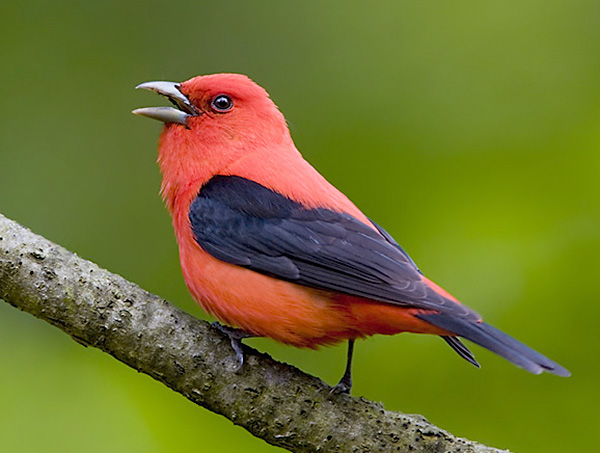
Photograph © Glenn Bartley.
The Scarlet-Tanager is a medium-sized songbird of leafy eastern forests. Males of this summer resident are deep scarlet red, have long, plush black wings, and a somewhat short, slightly forked, black tail.
Males also have a rather stout, gray beak. Female and fall migrant Scarlet Tanagers are yellowish-green with blackish wings and tail and often have indistinct pale eyerings. In fall and winter, their beaks can also be paler.
In spring and fall migration, we can see this beautiful bird in parks and many places with big trees. In summer, we find them in various eastern woodland habitats. However, they don’t usually visit feeders.
#12 Blue Jay
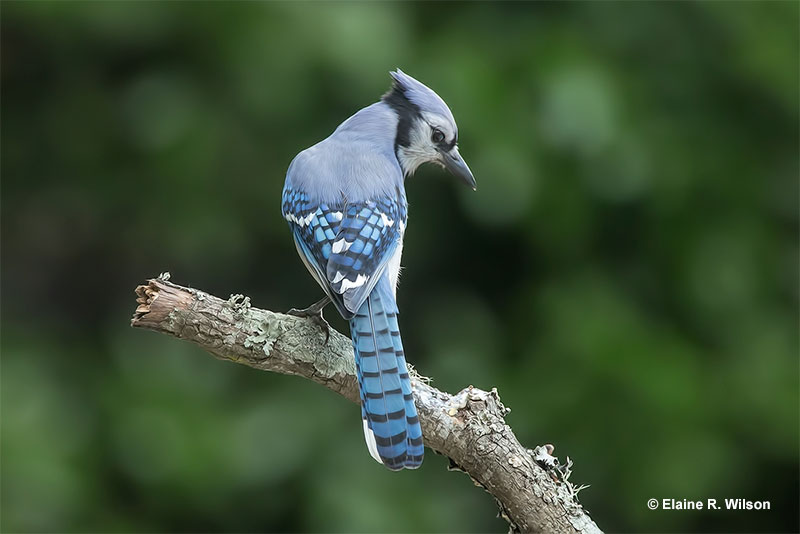
Blue Jays are crested birds with a thick black beak and a thin black collar that goes up the back side of their face. They have powder blue on their crest and back and brighter blue on their wings and white-tipped tail.
These flashy birds also have some white markings, black bars on their wings, and black bars on their tail. They also have a pale gray face with small black markings near their eyes, and a pale gray chest and flanks. The rest of their underparts are white.
Blue Jays live in oak woodlands, forests, parks, and many urban areas.
#11 Scissor-Tailed Flycatcher
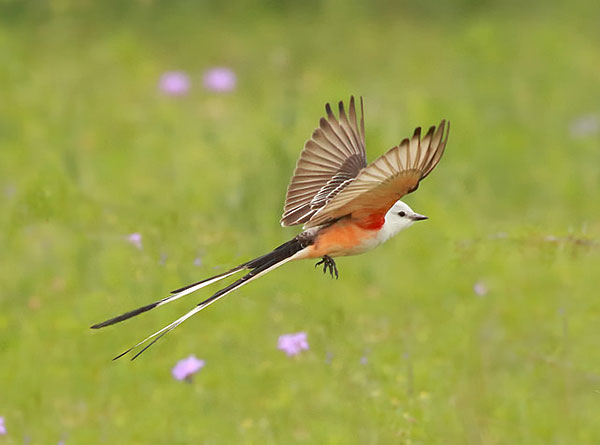
Scissor-tailed Flycatchers are elegant, long-tailed birds of the summer in open habitats from Kansas to Texas. They are pale gray with a bit of black in front of their eyes, and have rich salmon-pink coloration on their lower flanks and undertail.
In flight, Scissor-tailed Flycatchers also show this color on their wing linings and long black wings with some white edging. However, their most impressive field mark is their extra-long black and white tail.
Both sexes look the same and have black beaks, but males have longer tails. Juveniles are even paler gray and have pale yellow instead of salmon-pink.
#10 Rivoli’s Hummingbird

The Rivoli’s Hummingbird is a large, sparrow-sized hummingbird with a long, impressive beak, and green upperparts. Males have blackish underparts with some green highlights, a grayish undertail, and a blackish-green tail.
In most lighting, their head looks black, but when light hits it, they show a glowing, amethyst-purple crown, and a beautiful aquamarine throat.
Female Rivoli’s Hummingbirds have gray underparts with small marks on their throat, a narrow pale line behind their eyes, and a narrow pale line on the lower side of their face. They also have black and white on the tip of their tail.
We see Rivoli’s Hummingbirds in montane woodlands.
#9 Green Jay
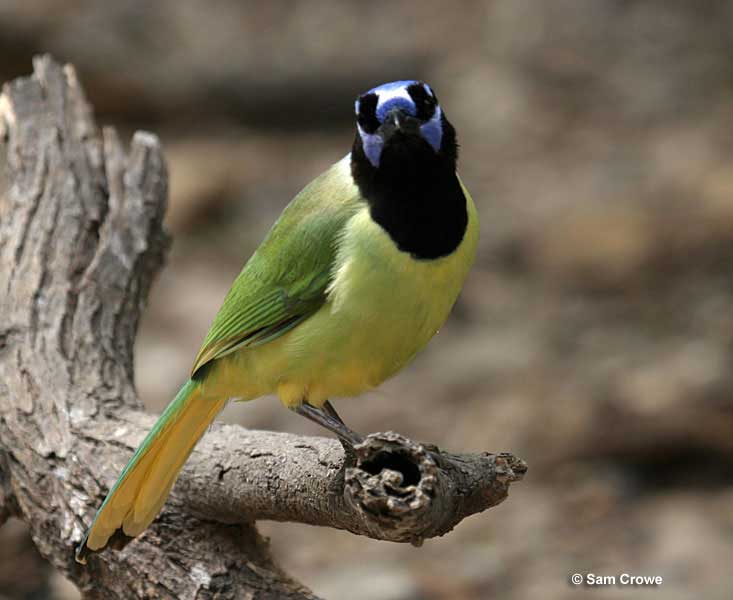
Found in North America, the tropical Green Jays are leafy green with yellow under their long tail, and have a velvet black throat.
They also have a black face with dark blue markings around their eyes, above their beak, and on the back of their head.
Both sexes look the same and also show a small white patch in front of their eyes. We can admire these beautiful, noisy jays in the lower Rio Grande Valley of Texas.
They are common in thorn forest, other brushy subtropical habitats, and even visit feeders!
#8 Lazuli Bunting
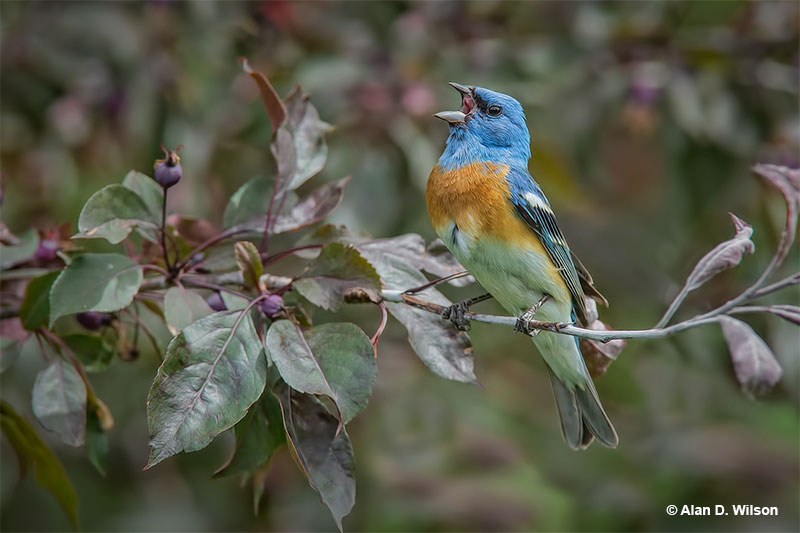
The Lazuli Bunting is a small, beautiful finch of dry, brushy habitats. Male Lazuli Buntings have a pastel blue head and back, and an orange chest and flanks. The rest of their underparts are white, and they also have two white bars on blue and black wings.
Female Lazuli Buntings don’t have any of the male’s bright colors but can show a bit of dingy blue in their wings and tail. They are plain pale gray-brown above and soft buff below with richer colors on their chest.
These little birds also have two buffy wing bars, and a hint of a broken buffy eyering.
#7 Ruby-throated Hummingbird
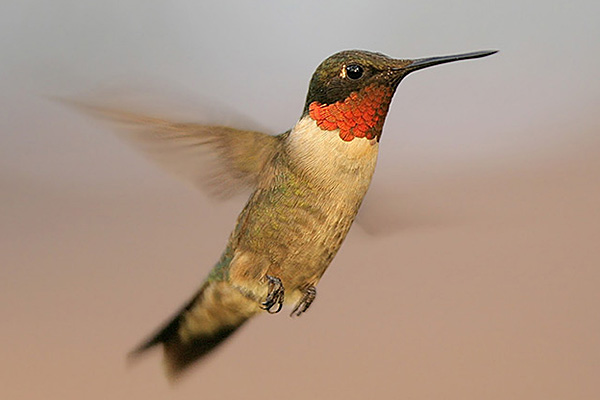
Photograph © Greg Lavaty.
The Ruby-throated Hummingbird is a small hummingbird with a long, needle-like, slightly curved beak. It also has a small pale spot behind each eye, a white semi-collar, and an iridescent green back.
Male Ruby-throated Hummingbirds have a small black chin and a shining, deep ruby-red throat. In dim lighting, their throat looks all dark. They also have olive-green-gray underparts, and a black, forked tail.
Female Ruby-throated Hummingbirds have a pale throat with small gray markings and have a tail with a black and white tip.
We can see this species in gardens, at hummingbird feeders, parks, and in all sorts of wooded habitats in eastern North America.
#6 Western Tanager
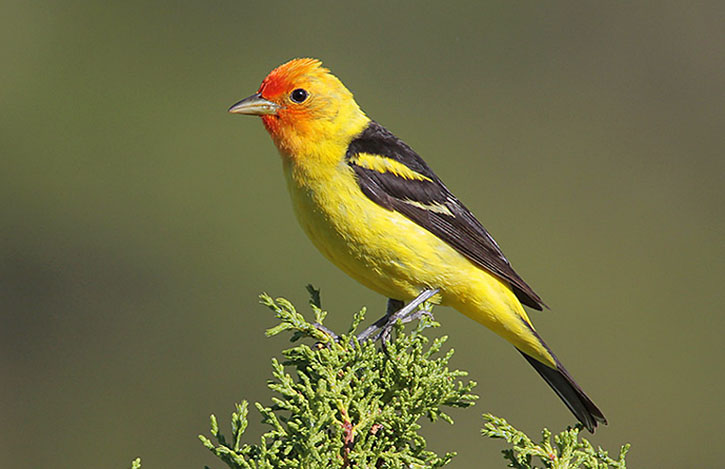
Western Tanagers are beautiful, medium-sized songbirds of western forests. Males are bright lemon yellow with an orange-rose head, gray beak, and black tail. They also have a jet back patch on their back, and long black wings with a yellow shoulder and one white wing bar.
Female Western Tanagers are greenish yellow or gray and yellow with a stout yellow-orange beak, and gray back. They also have a dingy yellow rump, and two pale yellow or white wing bars.
In flight, both sexes show some yellow under their wings.
Western Tanagers are common summer birds in coniferous forests, oak woodlands, and other wooded habitats in western North America.
#5 Allen’s Hummingbird
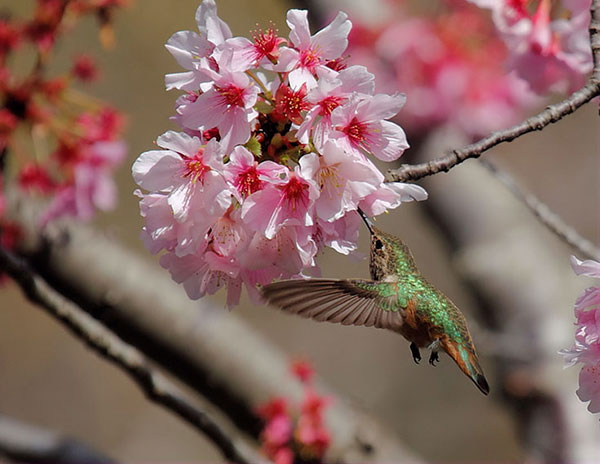
The Allen’s Hummingbird is a small hummingbird with a long, needle-like beak, small white spot behind each eye, and bright, leaf-green upperparts. Males have rufous-orange on their belly, face, and tail. They also have a shining orange-red throat.
In some lighting, their throat looks dark but can have a coppery glow as the bird moves its head. Females have a white throat with small gray streaks, less orange below, and an orange and green tail with a black and white tip.
Allen’s Hummingbirds feed in chaparral and other brushy habitats on the Pacific coast and in other parts of the American Southwest and Mexico.
#4 Black-Chinned Hummingbird
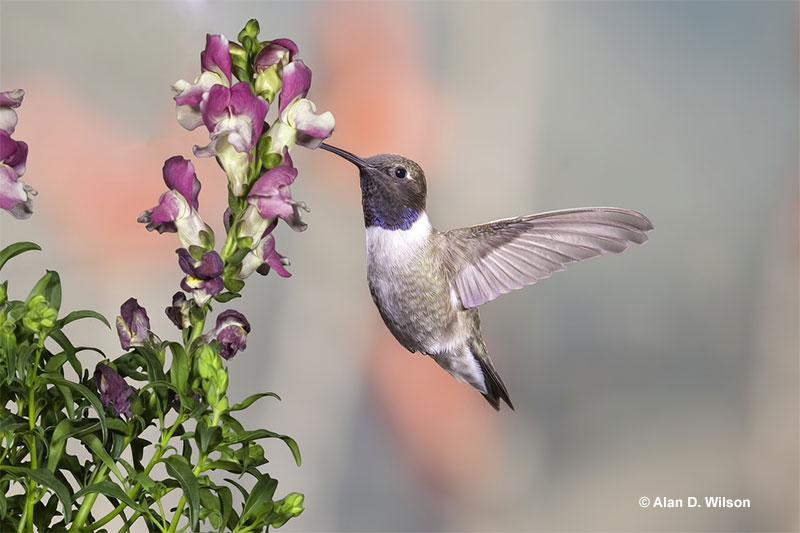
Black-chinned Hummingbirds are a small hummingbird species with a pale semi-collar. They also have a long, slightly curved beak, a small pale spot behind each eye, and an iridescent golden-green back.
Males have a dark throat with a black chin and a black, forked tail. In certain lighting, they show deep, glowing purple colors on their throat! The rest of their underparts are pale gray and white.
Females are similar but have grayish markings on their throats, and small white spots on their tail.
We find Black-chinned Hummingbirds in western riparian zones, gardens, and lots of other open arid habitats in western North America.
#3 American Goldfinch

The American Goldfinch is another strong contender for being the prettiest bird on the block. Breeding males are bright lemon yellow, have a smart black cap, and black wings with white highlights. They also have a black and white tail and a white undertail.
In fall and winter, males resemble female goldfinches. These birds are still pretty but are more subtly plumaged in buff, pale gray, and yellow. We can also recognize them by their buff or yellowish wing bars.
American Goldfinches live in weedy fields, parks, suburbs, and other open areas. They can also visit backyard bird feeders.
#2 Northern Flicker
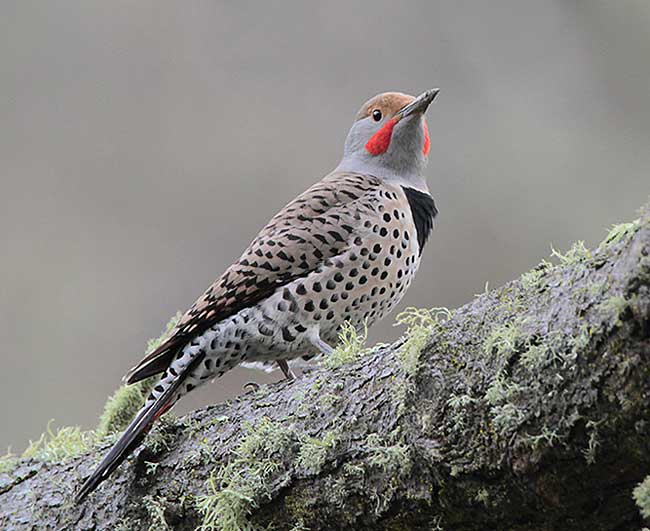
The Northern Flicker is a large tan woodpecker with a big white rump, black barring above, and black spotting below. They also have a big black patch on their chest and a straight, strong black beak.
Males have a brown and gray head with a red or black mustache mark. Male Northern Flickers in the east also have a small red patch on the back of their head. Female Northern Flickers look like males but lack the mustache mark.
In flight, they show bright yellow or reddish on their underwings.
Northern Flickers live in parks, on golf courses, open woodlands, and other semi-open habitats.
#1 Painted Bunting
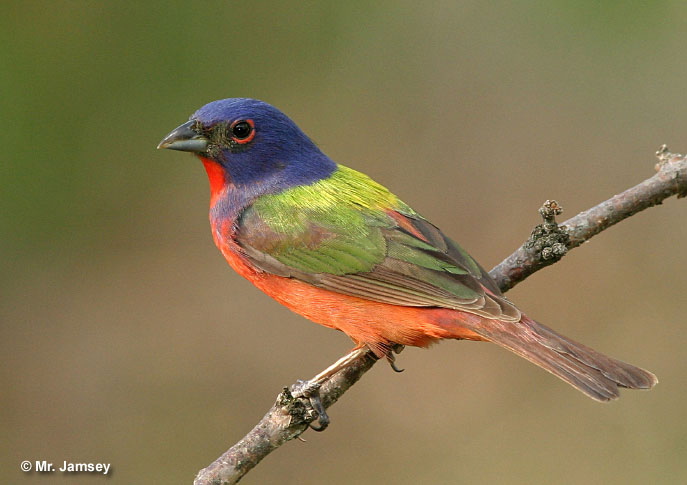
The Painted Bunting has so many colors it looks like someone gave some crayons to a child and told them to make the prettiest bird they could imagine! Males of this small finch have bright red underparts, a bit of red around their eyes, and red on their lower back.
They also have a beautiful purple-blue head with red on their throat and lime-green on their back, wings, and tail.
Females don’t look as gaudy but are still pretty. They have gray-greenish plumage above, a green-yellow eyering, and have greenish-yellow underparts.
Painted Buntings live in brushy habitats and second growth.
Let us know, which one is your favorite!

